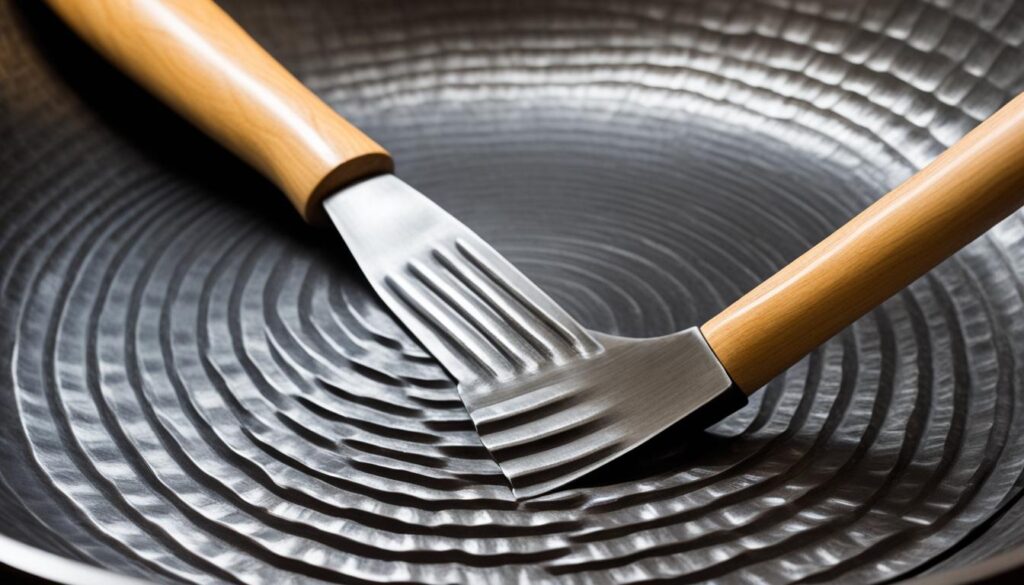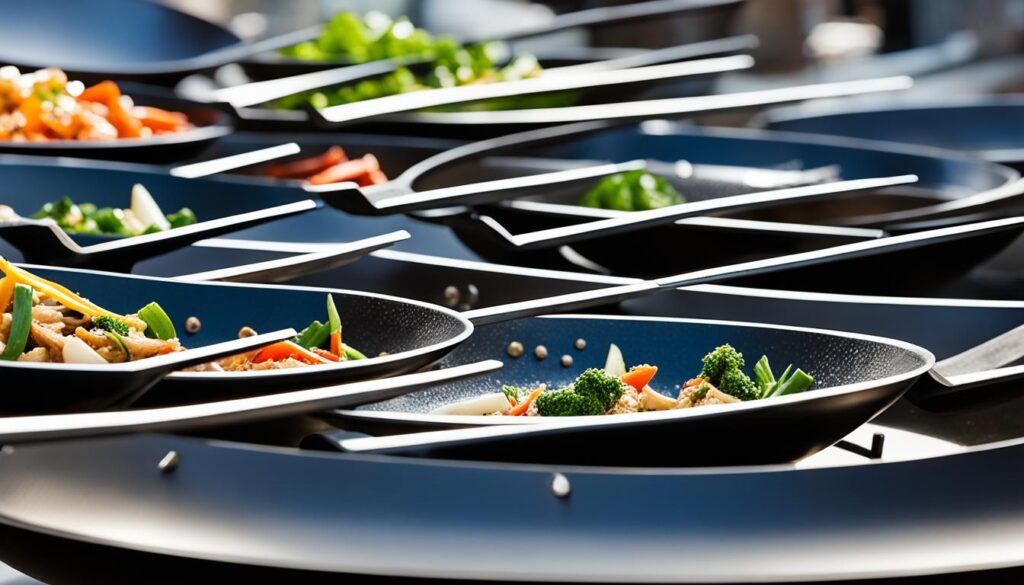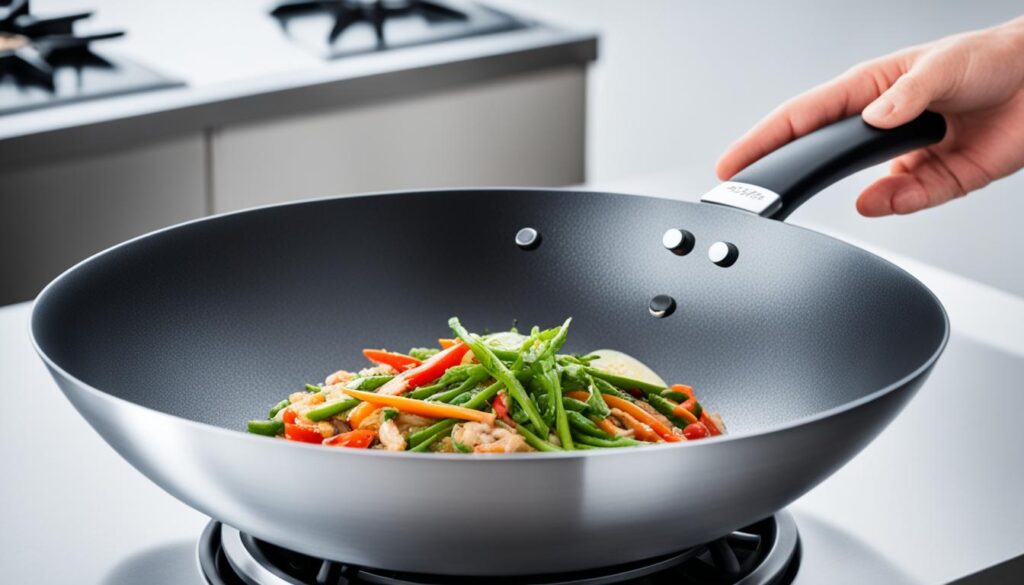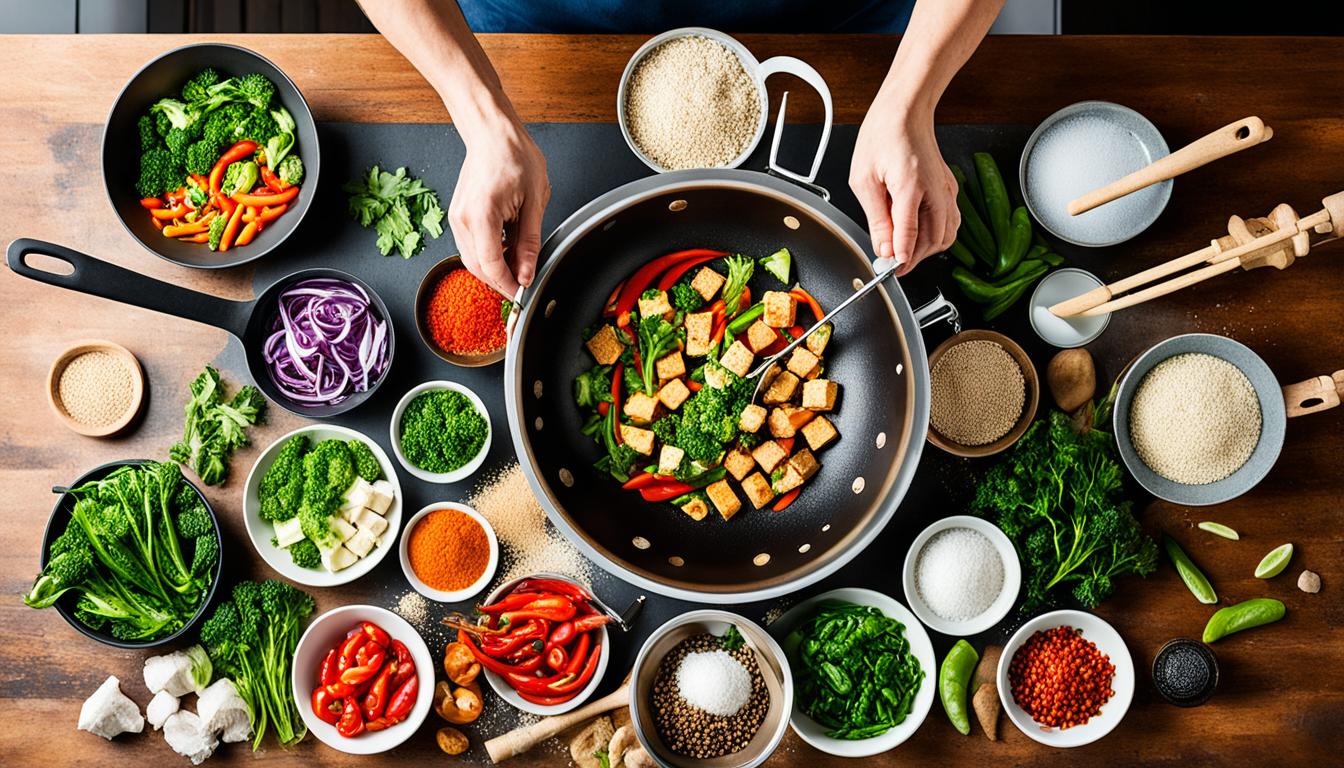Are you ready to stir-fry your way to delicious meals, but unsure about the best wok to buy? Don’t fret! We’ve got you covered with a comprehensive guide on everything you need to know about selecting the perfect wok for your kitchen. From materials and construction to shape and size, we’ll walk you through the essential factors to consider so you can make an informed decision. Say goodbye to sticky pans and hello to culinary perfection!
Key Takeaways:
- Carbon steel woks are the preferred choice due to their heating properties, durability, and ability to develop a nonstick surface.
- Consider the construction type, such as hand-hammered or spun woks, for affordability and cooking advantages.
- Choose a wok shape and size that suits your cooking needs and stove type.
- Opt for woks with handles and lids that enhance maneuverability and cooking versatility.
- Master the art of wok hei, the smoky flavor achieved through proper cooking techniques.
Why Carbon Steel Woks are the Best
When it comes to choosing the best wok, carbon steel is undoubtedly the top contender. Carbon steel woks have gained popularity among chefs and home cooks alike due to their exceptional performance and numerous benefits.
One of the key advantages of a carbon steel wok is its ability to heat up quickly and evenly. This allows for efficient and consistent cooking, ensuring that your dishes are cooked to perfection. Whether you’re stir-frying, sautéing, or deep-frying, a carbon steel wok will provide the optimum heat distribution necessary for excellent flavor development.
Another highlight of carbon steel woks is their high responsiveness to heat adjustments. This means that you have greater control over your cooking, allowing you to sear, simmer, or fry with precision. From delicate stir-fries to intense high-heat cooking, a carbon steel wok can handle it all.
Not only are carbon steel woks functional, but they are also durable and affordable. Made from sturdy material, they can withstand high temperatures and are built to last. Additionally, carbon steel woks are relatively budget-friendly compared to other materials, making them an accessible choice for home cooks.
With proper care and seasoning, a carbon steel wok can develop a natural nonstick surface. This not only makes cooking and cleaning easier but also enhances the overall cooking experience. The seasoned patina adds depth and complexity to your dishes while preventing food from sticking.
When choosing a carbon steel wok, it’s essential to consider the thickness. We recommend opting for a wok that is at least 14 gauge in thickness to ensure durability and to avoid any potential bending or warping.
Overall, the benefits of a carbon steel wok make it the best choice for both professional chefs and home cooks. Its heat conductivity, responsiveness, durability, affordability, and nonstick properties set it apart as the ultimate wok material.
Image:
Types of Wok Construction
When it comes to wok construction, there are several options to choose from. Each construction type offers unique features that can affect your cooking experience. Let’s explore the different types of wok construction:
Hand-Hammered Wok
A hand-hammered wok is crafted with slight indentations on the surface. These indentations allow you to push the food to the sides without worrying about it slipping back into the center. Hand-hammered woks provide superior heat distribution and are highly durable. They are a popular choice among professional chefs.
Stamped Wok
Stamped woks are made by cutting out a circular piece of thin carbon steel and machine-pressing it into a mold. This process results in a smooth surface that may make stir-frying difficult as the food tends to stick. Stamped woks are often more affordable compared to other construction types.
Spun Wok
Spun woks are produced on a lathe, creating concentric circles on the surface. These concentric circles offer similar advantages to hand-hammered woks, such as better heat distribution and easy food movement. Spun woks are considered a reliable and affordable option.
We believe that the best wok construction depends on personal preference and cooking style. Hand-hammered and spun woks are both excellent choices for their performance and affordability.
| Construction Type | Features |
|---|---|
| Hand-Hammered Wok | Slight indentations for easy food movement Superior heat distribution Highly durable |
| Stamped Wok | Smooth surface may make stir-frying more challenging Affordable option |
| Spun Wok | Concentric circles for better heat distribution Easy food movement Affordable option |

Now that we have a better understanding of wok construction types, let’s move on to the next section where we will discuss the importance of choosing the right shape and size for your wok.
Choosing the Right Wok Shape and Size
The shape and size of a wok are crucial factors to consider when purchasing one for your kitchen. The right wok shape and size can significantly impact your cooking experience and the quality of your dishes.
Round-bottomed woks are not recommended for electric ranges due to their instability. Even on gas ranges, they can be challenging to use and may not distribute heat evenly. For optimal performance, it is best to choose a wok with a flat bottom that has a four to five-inch flattened area. This design provides a balance between high-heat space and maneuverability, allowing you to stir-fry and cook with ease.
When selecting the size of your wok, consider both your personal cooking needs and the size of your stove. Professional woks are typically 13 to 14 inches, which provide ample space for cooking large quantities of food. For home use, woks ranging from 10 to 20 inches are commonly available, catering to various cooking requirements.
Now, let’s take a look at a table that summarizes the advantages and disadvantages of different wok shapes and sizes:
| Wok Shape | Advantages | Disadvantages |
|---|---|---|
| Round-bottomed | – Traditional design – Ideal for gas ranges |
– Not suitable for electric ranges – Less stability |
| Flat-bottomed with four to five-inch flattened area | – Provides stability and even heat distribution – Suitable for various cooking techniques |
– May require more storage space |
Choosing the right wok shape and size will greatly enhance your cooking experience and allow you to achieve the best results in the kitchen.

Now that we understand the importance of selecting the right wok shape and size, let’s move on to explore the different handle and lid options available for woks.
Handle and Lid Options for Woks
When it comes to woks, handle and lid options play a crucial role in the overall cooking experience. Different handle designs offer unique advantages, while lids provide added functionality. Let’s take a closer look at the various handle and lid options available for woks.
Cantonese-Style Woks
Cantonese-style woks feature small handles on either side of the wok. These handles allow for easy maneuverability and a comfortable grip. While Cantonese-style woks are popular, they may require more effort when it comes to flipping and stir-frying due to the lack of a long handle.
Northern-Style Woks
On the other hand, Northern-style woks come with a single long handle and a smaller helper handle on the opposite side. This design is highly preferred by many chefs and home cooks alike. The long handle enables effortless flipping and stir-frying, while the helper handle provides better control and easier lifting. This combination makes Northern-style woks a versatile option in the kitchen.
Wok Lids
In addition to handle options, woks can also be equipped with lids. Wok lids are useful for simmering food and trapping steam for faster cooking. They help retain moisture and enhance the overall cooking process. Whether you’re steaming vegetables or braising meats, having a lid for your wok can make a significant difference in achieving delicious results.
Now that we understand the handle and lid options for woks, let’s move on to the next section which discusses the art of “wok hei”, a technique that adds smoky flavors to wok-cooked dishes.

| Handle Options | Lid Options |
|---|---|
| Cantonese-style woks | Available without lids |
| Northern-style woks | Can be paired with lids |
The Art of Wok Hei
When it comes to wok cooking, there’s a distinct element that sets it apart from other cooking methods – wok hei. Wok hei refers to the smoky, singed flavor that is characteristic of dishes cooked in a wok. It is often described as a complex depth of flavor that adds a unique touch to stir-fries and other wok-cooked delicacies.
So, how do you achieve wok hei? It all comes down to the combination of three key factors: oil breaking down, fat vaporizing, and the searing of sauces. When the oil in the wok reaches high temperatures, it begins to break down, creating a smoky aroma and adding a depth of flavor to the food. As the fat in the ingredients vaporizes, it contributes to the overall smokiness and richness of the dish. Lastly, the searing of sauces in the hot wok caramelizes them, enhancing their flavors and intensifying the overall taste experience.
Wok hei is not only about the taste but also about the visual appeal of the dish. The intense heat and quick cooking time create a beautiful sear on the ingredients, enhancing their appearance and adding a touch of complexity to the overall presentation.
“Wok hei is the secret ingredient that transforms a simple stir-fry into an unforgettable culinary experience.”
Why is Wok Hei Important?
Wok hei is highly valued in Asian cuisine, particularly Chinese and Southeast Asian cooking. It adds a unique smoky flavor and depth to dishes that cannot be replicated with other cooking methods. The combination of high heat and fast cooking ensures that the ingredients retain their texture, color, and nutrients, resulting in vibrant and delicious meals.
Wok hei is considered the hallmark of a well-executed stir-fry or wok-cooked dish. It is a testament to the skill and technique of the chef, showcasing their ability to control the intense heat of the wok and create a harmonious balance of flavors and textures.
Moreover, wok hei is closely tied to the cultural heritage of wok cooking. It is a tradition passed down through generations, representing the mastery of a cooking technique that requires precision, intuition, and understanding of the ingredients.
Enhancing Wok Hei
If you want to elevate the wok hei in your dishes, here are a few tips:
- Preheat your wok properly: Make sure to heat your wok until it is smoking hot before adding any ingredients. This ensures that the oil breaks down quickly and creates the desired smoky flavor.
- Use the right oil: Opt for oils with high smoke points, such as peanut oil, canola oil, or vegetable oil. These oils can withstand the high temperatures needed for wok cooking without burning or becoming bitter.
- Control the heat: Wok cooking requires fast and intense heat. However, it’s important to maintain control and prevent the food from burning. Adjust the heat as needed throughout the cooking process to maintain the desired smoky flavor.
- Add sauces and aromatics at the right time: To achieve maximum flavor and wok hei, add sauces and aromatic ingredients towards the end of the cooking process. This allows them to sear and caramelize quickly, intensifying their flavors.
Achieving wok hei may take some practice and experimentation, but the results are well worth it. The smoky, singed flavor adds a whole new dimension to your dishes, making them truly memorable and satisfying.
Seasoning and Care for Your Wok
When it comes to carbon steel woks, proper seasoning and care are essential for maintaining their performance and longevity. Seasoning is the process of creating a nonstick surface on the wok, ensuring that your food cooks evenly and doesn’t stick to the surface.
To season your wok, start by removing the protective oil film that comes with it. This can be done by scrubbing the wok with a brush and hot water, without using soap. Once cleaned, thoroughly dry the wok to prevent rusting.
Next, heat the wok over medium heat to remove any remaining moisture. This helps open up the pores of the metal, allowing the oil to penetrate and create a protective coating. Once the wok is hot, add a thin layer of oil and spread it evenly across the surface using a heat-resistant brush or paper towel. Heat the wok until the oil starts to smoke and then remove it from the heat.
Allow the wok to cool down naturally, and then wipe off any excess oil with a paper towel. Your wok is now seasoned and ready to use. With each use, the nonstick coating will improve, making cooking and cleaning easier.
After cooking with your wok, rinse it with hot water and use a gentle scrub brush to remove any food residue. Avoid using soap unless necessary, as it can strip away the seasoning. If needed, a small amount of dish soap can be used, but make sure to rinse it thoroughly afterwards.
To prevent rusting, make sure the wok is completely dry before storing it. You can place it back on the stove over low heat for a few minutes to ensure all moisture evaporates. Once dry, apply a thin layer of oil to the surface to create a protective barrier.
It’s important to note that water should be avoided when caring for your wok, as it can cause rusting. Additionally, acidic ingredients should be washed off promptly to prevent damage to the wok’s seasoning.
Remember: Proper seasoning and care are crucial for enjoying your wok for years to come. By following these simple steps, you can ensure that your wok remains in excellent condition and continues to enhance your cooking experience.
Recommended Woks to Buy
When it comes to purchasing a wok, we highly recommend considering the Yosukata Black Carbon Steel Wok and the Joyce Chen wok. These options have proven to be top contenders in terms of quality, performance, and value for money.
The Yosukata Black Carbon Steel Wok stands out for its exceptional heat-responsiveness. Made from durable carbon steel, this wok heats up quickly and evenly, ensuring that your ingredients are cooked to perfection every time. It also boasts an easy seasoning process, allowing you to develop a natural nonstick surface for efficient cooking and hassle-free cleaning. Plus, the Yosukata wok is reasonably priced, making it an excellent investment for both professional chefs and home cooks.
If you’re looking for a more budget-friendly option, the Joyce Chen wok is a fantastic choice. Also crafted from carbon steel, this wok delivers reliable performance at an affordable price point. Its construction ensures even heat distribution, allowing you to achieve consistent cooking results. With proper care and maintenance, the Joyce Chen wok can last for years, making it a smart purchase for those who want high-quality wok cooking without breaking the bank.
Both of these recommended woks are made from carbon steel, which is widely regarded as the best material for woks due to its heat conductivity, durability, and ability to develop a natural nonstick coating. With either the Yosukata Black Carbon Steel Wok or the Joyce Chen wok, you can confidently embark on your culinary adventures and create delicious stir-fries, deep-fried dishes, and more.
Essential Tools for Wok Cooking
When it comes to wok cooking, having the right tools is essential to ensure a successful and enjoyable experience in the kitchen. Whether you’re stir-frying, flipping, deep-frying, steaming, or braising, these must-have wok cooking tools will help you achieve professional results.
1. Chuan (Wide Spatula)
A chuan, also known as a wide spatula, is a versatile tool that allows you to toss and flip ingredients easily. Its broad surface and long handle provide excellent control and help prevent food from falling out of the wok.
2. Wooden Spoon or Spatula
A wooden spoon or spatula is ideal for stirring and mixing ingredients in a wok. Its smooth surface and gentle material prevent scratching the wok’s surface while ensuring even distribution of flavors.
3. Spider (Strainer)
A spider, or strainer, is a must-have tool for removing ingredients from hot oil or boiling water. Its wide, shallow basket design allows for easy drainage and prevents excessive oil or liquid from being transferred to the plate.
4. Bamboo or Metal Steamer
Steaming is a popular cooking method in wok cuisine, and a bamboo or metal steamer is essential for this technique. Whether you’re cooking dumplings, vegetables, or fish, a steamer ensures even heat distribution and retains the natural flavors and nutrients of the ingredients.
5. Steaming Rack
A steaming rack is used in conjunction with a wok and a steamer to elevate the food above the water level, allowing for proper steaming. It ensures that the ingredients are evenly cooked and prevents them from getting soggy or overcooked.
6. Lid
A lid is a versatile accessory that helps trap heat and steam, reducing cooking time and allowing flavors to meld together. It’s particularly useful when simmering food or when you need to contain splatter while stir-frying.
7. Hot Dish Tongs
Hot dish tongs are long-handled tongs with flat, wide blades that provide a secure grip on hot dishes and allow for easy maneuvering. They are invaluable when transferring food from the wok to serving plates.
8. Oil Squeeze Bottle
An oil squeeze bottle is a convenient tool for controlling the amount of oil added to the wok. It allows for precise drizzling and ensures even distribution, preventing excessive oiliness in your dishes.
9. Chopsticks
Chopsticks are a staple utensil in Asian cuisine and are indispensable for wok cooking. They provide precision and control when handling smaller ingredients and are excellent for stirring, tossing, and serving.
10. Prep Bowls
Prep bowls are small bowls used to hold pre-measured ingredients before cooking. They help keep the cooking process organized and facilitate the quick and efficient addition of ingredients to the wok.
By equipping yourself with these must-have wok cooking tools, you’ll be well-prepared to tackle any recipe and elevate your culinary skills. Whether you’re a seasoned chef or a beginner in the kitchen, these essential accessories will make wok cooking a breeze.
Conclusion
After considering the material, construction, shape, size, handle and lid options, and seasoning process, we can conclude that carbon steel woks are the ideal choice for purchasing. These woks offer excellent heat responsiveness, ensuring even and efficient cooking. They are also highly durable, making them a long-lasting investment for your kitchen. Moreover, carbon steel woks have the unique ability to develop a nonstick surface with proper care, making cooking and cleaning much easier.
Among the top recommendations for carbon steel woks are the Yosukata and Joyce Chen brands. The Yosukata wok excels in heat responsiveness, ease of seasoning, and affordability, while the Joyce Chen wok offers a budget-friendly option without compromising on quality.
With the right tools and care, a wok becomes a versatile and essential addition to any kitchen. Whether you’re stir-frying, deep-frying, steaming, or braising, a well-chosen wok can elevate your culinary skills and create delicious meals with authentic flavors. So, don’t hesitate to invest in a quality carbon steel wok and explore the endless possibilities of wok cooking.
